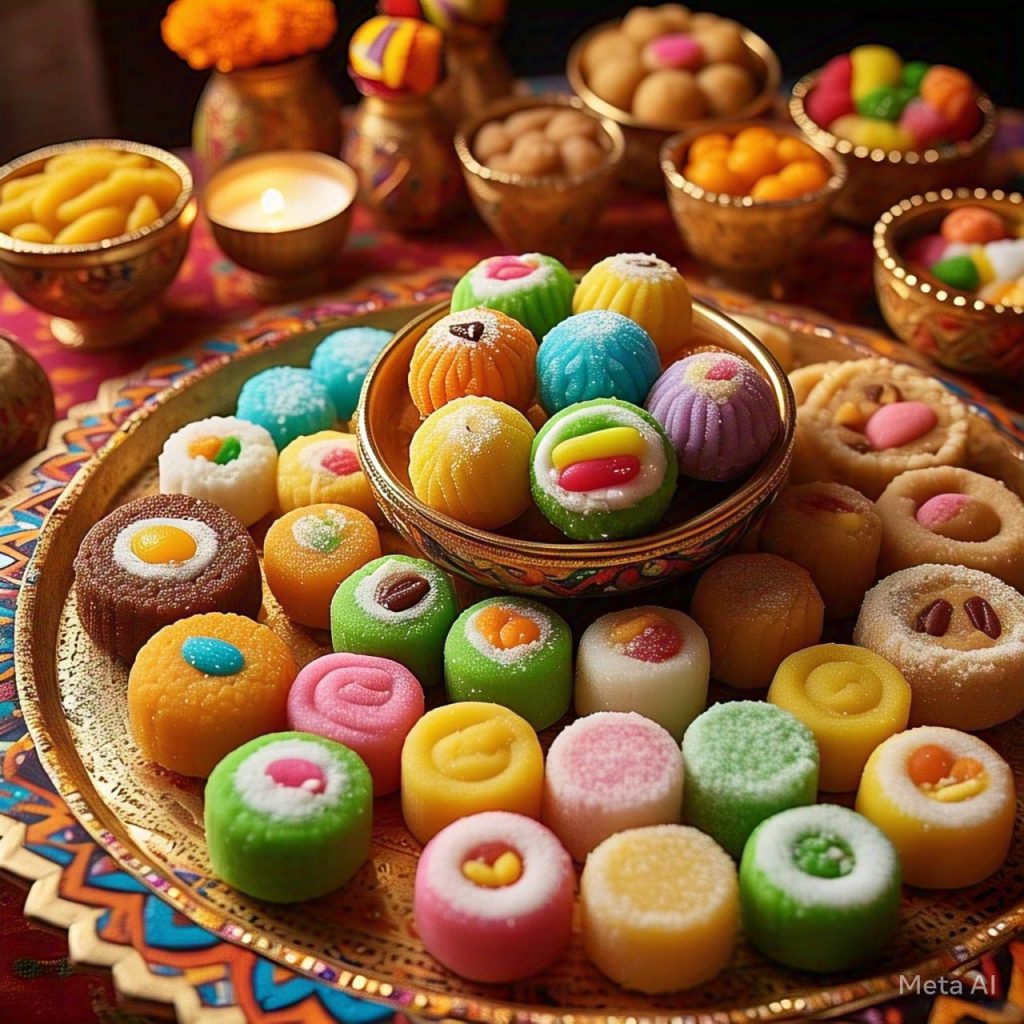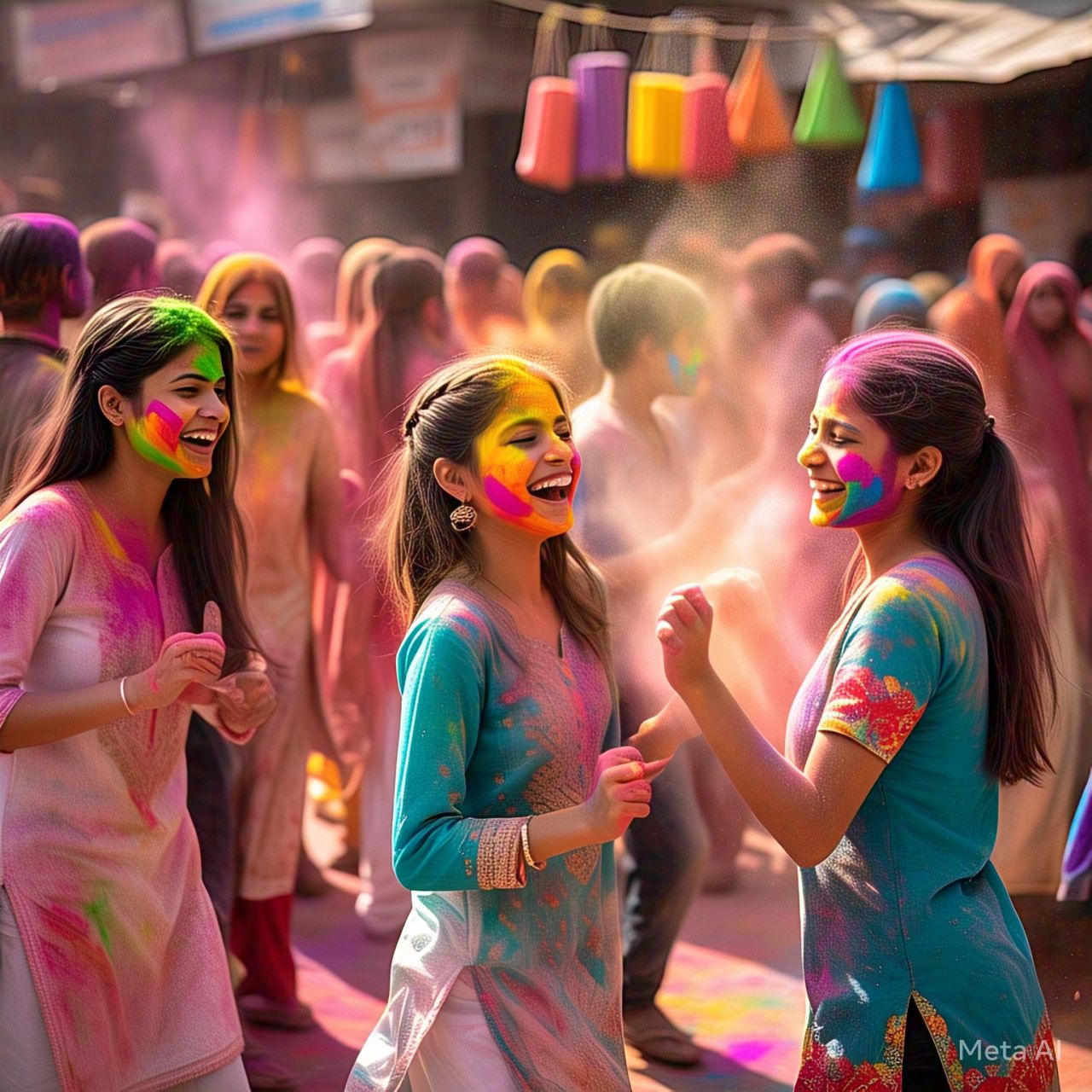It’s the day when streets turn into rainbows, old clothes become canvases, and laughter echoes through neighborhoods. Holi, often called the Festival of Colors, is one of the most joyful and widely celebrated festivals in India. It marks the arrival of spring, the end of winter, and the blossoming of new beginnings.
But Holi is more than just throwing colors — it’s deeply rooted in Indian culture, mythology, and emotion. It celebrates the victory of good over evil, especially through the story of Prahlad and Holika, where faith triumphed over cruelty. It also honors Radha and Krishna’s playful love, reminding us that love and mischief can go hand in hand.
Families gather the night before for Holika Dahan, lighting bonfires to symbolically burn negativity. And the next morning? It’s pure joy — colors in the air, sweets in hand, music playing, and hearts full.
In Indian celebration, Holi is the time to forgive, reconnect, and rejoice — to color not just faces, but lives, with laughter and love.
The roads are hushed to begin with, seemingly deceivingly calm. But if one hears closely enough, there’s the sound of laughter simmering in the horizon. Buckets are being filled with water, paints are being colored, and trunks are being rummaged for those worn-out, plain white kurta — not because they’re expensive, but because they’re the best for letting in all the craziness of color.
This is Holi. A celebration that’s as much about mischief and mayhem as it is about myths, spring, and the sheer happiness of being together.

Why Is Holi Celebrated? The Stories That Shape the Festival
The most famous origin myth of Holi is from Hindu mythology — the story of Prahlad and Holika.
Prahlad was a devoted young boy and a firm devotee of Lord Vishnu. But his father, King Hiranyakashipu, was a tyrant who wished that everyone worship him instead. Angry at Prahlad’s devotion to Vishnu, the king decided to slay him.
He requested his sister Holika, who was in possession of a magical cloak that kept her safe from the flames, to sit on a pyre that was on fire with Prahlad in her lap. The scheme was merciless — Holika would be spared while Prahlad would perish. But the cloak was carried away from her and settled over Prahlad instead. Holika was destroyed by the flames, and Prahlad remained alive.
This triumph of faith and virtue over arrogance and evil is celebrated as Holika Dahan, an evening ritual bonfire preceding Holi.
Krishna and Radha: The Color of Love
Yet another very popular legend hails from Vrindavan, where Lord Krishna, famous for being naughty, feared his dark complexion might be rejected by fair Radha.
His mother jokingly asked him to color Radha’s face so that the two could be made equal. Krishna did exactly that, and a new custom of smearing color — one of love, play, and equality — was born.
Actually, in Vrindavan and Mathura, Holi is celebrated with a seven-day festival of color, music, and even mock battles between men and women!
What Do People Do During Holi?
Each Holi may be different based on where you are, but some universal themes tie the festival together throughout India (and even outside of it): togetherness, color, food, music, and forgiveness.
1. Holika Dahan – The Night Before
On the eve of , individuals sit around a bonfire. Families take twigs, old wooden pieces of furniture, and dried leaves to burn away ego, negativity, and past grudges. Some offer small bundles of crops to the fire as a prayer for a good harvest.
It’s symbolic — you release what no longer serves you.
Human beings go around the fire, pray, and chant classic folk songs. The children laugh as they throw popcorn into the fire, while the elderly utter soft prayers for health and peace.
2. Rangwali Holi – The Day of Colors
This is the Holi everyone knows — the festival of colors.
Men and women, men and women collect in open squares, parks, terraces, and streets. The rules are straightforward: nobody is exempted, and anybody becomes a painting surface. Powdered gulals swirl through the air — pink, purple, blue, yellow. Some make soft strokes on faces with paint; others bombard full-scale water balloon attacks.
Water pistols (or pichkaris) are loaded with colored water. Drums and speakers emit music. Kids dash about soaked, while the older generation observes with smiling faces — until someone decides they want a splash of color as well!
It’s noisy. It’s messy. And it’s unbelievably entertaining.
The Flavors of Holi: A Feast for the Senses
What is Holi without food? It’s a day in which sweet and spicy come together, and old-school snacks lead everyone to the kitchen (and later to the couch for a nap).
Must-Have Holi Treats
- Gujiya – Fried dumplings stuffed with khoya, coconut, and dry fruits. Sweet, flaky, and addictive.
- Thandai – A cold milk beverage flavored with saffron, cardamom, rose petals, almonds, and most importantly, a splash of bhang in some parts of the country.
- Dahi Bhalla & Chaat – spicy, tangy, and loaded with crunchy sev — ideal to counter the gujiyas’ sweetness.
- Malpua, Puran Poli, and Kachoris — region-dependent but always delicious.
- At home, Holi is a cover for an open house — neighbours and friends visit, eat, laugh, and leave their holi handprint on your walls… literally.

The Spirit of Forgiveness and Renewal
There’s a reason why people say “Bura na mano, Holi hai!” — that is, “Don’t mind, it’s Holi!”
It’s a celebration in which forgotten feuds are forgotten, rivalries melt away, and everyone greets each other with open arms. You may see long-lost friends reuniting, family members embracing after months of cold shoulders, or neighbors accepting a plate of sweets after years of forced nods.Holi reminds us that life is too short to be bitter. As the color is washed away, so should the burden of resentment.
How Holi Is Celebrated Throughout India
Although the essence of Holi remains the same everywhere, regional flavors give it a wonderfully diverse shape:
Barsana & Vrindavan (Uttar Pradesh):
Famous for Lathmar Holi, where women playfully beat men with sticks in a light-hearted tradition that depicts the love stories of Radha and Krishna. Individuals travel from across the globe to see this.
Shantiniketan (West Bengal):
Festive as Basanta Utsav, this form of Holi draws its inspiration from the poetic touch of Rabindranath Tagore. Individuals dress in yellow, sing folk songs, and dance in open fields.
Punjab:
Holi becomes Hola Mohalla, particularly with Sikhs. It’s less colorful and more about demonstrations of power, martial arts, and solidarity.
Maharashtra:
Locals celebrate Matki Phod, in which young males create human pyramids to smash up pots of buttermilk suspended high above — inspired by Lord Krishna’s mischief during his childhood.
Holi is the time to celebrate friendship, love, and new beginnings
